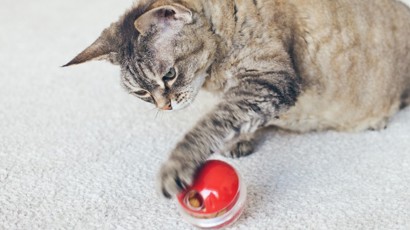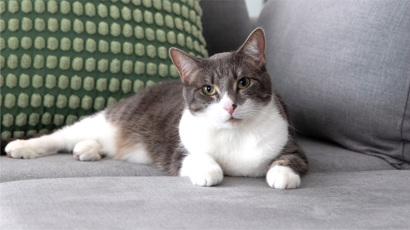Good Health doesn't have to be a Weighty Issue for your Cat

While they love a sunny spot in the garden or the comfy warmth of the sofa, your lap, or even laptop, cats don’t deserve the ‘lazy’ branding they often receive.
When in tip-top shape they’re more agile, alert and responsive. They’re able to jump, pounce, play and chase with ease, as well as exploring the spots in their territory with energy and vigour when at a healthy weight.
I find that conversations about the weight of your cat can be difficult if we don’t have them frequently. Just the same as you and I though, responsible caretaking of our (and their) bodies is something that will never cease, so we should face into it as a big achievement in pet ownership.
Yes, this article is about ‘responsible pet ownership’, but more so about looking at weight issues and weight management in cats from a few different, interesting angles:
Energy is a great starting point
Weight management can be boiled down to a simple ‘energy in’ vs. ‘energy out’ equation. When more calories are being consumed than spent, then they are stored in the body as additional body mass.
Anyone who has had a ‘heavy’ pet or needed to shift a few kilos themselves know that the solution to weight management isn’t that easy. It’s a very complicated interaction between what your cat’s body needs to survive on a day-to-day basis (body maintenance and repair, which is influenced by their age, size, muscle mass and hormonal status) plus the energy needed to fuel their activity (dependent on lifestyle, environment and mobility) measured against what they’re being fed.
Already we can see that shifts in weight are ‘multifactorial’, meaning that many contributors can lead to gains (or losses), and that they often change, meaning that our cats are more or less prone to becoming overweight or obese at different times in their lives.
All foods are not created equal
When walking up and down the pet food isle it may not be obvious that you’re looking at options that are highly variable in calorie content.
Just the same as with our own food, the nutrition tables on the back, side or bottom of every product can be difficult to interpret, and even more difficult to compare with one another.
If in doubt, and looking for a weight management diet, it’s best to steer towards familiar brands and products with clear features. This includes ‘reduced calorie’, ‘light’ or ‘weight management’ claims, which should be backed up by the company making it.
If things don’t ‘measure up’ or you’d like to know about the specifics, a good manufacturer will have a customer services team ready to help. Otherwise, know that help is at hand in the form of pet care specialists, nutritional advisors as well as the team at your vets. They can help you find the product which is the best fit for our cat.
Cats aren't as fussy as some think
‘Fussiness’ is another reputational issue for our cats.
This stems from our friend’s natural instincts to eat according to their energy requirements and to have multiple small meals per day. Think about the farm cat that chases down mice, expending a lot of mental and physical energy while securing themselves a meal that won’t necessarily fulfil their energy requirements all in one go. They’ll go out on a hunting expedition as often as they need to, because they’re fit and healthy.
Then compare this farm cat situation to what’s happening with the majority of our cats today, who can often be housed in smaller areas with less territory, sometimes indoors and with less and less motivation to live anything but a sedentary life.
On top of this, a delicious (sometimes higher-calorie-than-needed) meal is set in front of them, without need to expend any energy in seeking it out. It’s all too easy!
We owners can sometimes unknowingly compound the issue by allowing ‘grazing’ from a full bowl of food throughout the day. This isn’t necessarily a bad practice if your cat shows the self-control to only eat what they need, but when ideal daily meal volumes can be 20-30 grams, every kibble / every mouthful counts… weight gain is easier than you think.
When allowed to graze from a full bowl, the valuable resource that is food is available ‘on-tap’, so your cat doesn’t necessarily feel the need to gulp it all down in one helping. They know they can come back to it later, satisfying their natural preference to ‘seek food when hungry’.
By leaving food in the bowl however, some pet parents assume that their cat is rejecting it, that it’s not appealing or palatable or that their cat is ‘fussy’.
If we put everything into context, we’ll realise that our cats are simply managing their own meals, that they’re NOT suffering of dietary boredom and DON’T need another food put out if their appetite is healthy.
Particularly if they tend to carry excess weight, adding another palatable food to their smorgasboard is going to do more harm than good.
You can take the reigns
The great thing about all of this is that while our feline overlords may object to it, we humans are still largely in control (at least of their food and feeding). It may be a challenge if your cat has outdoor access and pops to the neighbours’ food bowls but apart from navigating these issues, we are the ones that select our cat’s food, decide on the way in which it is delivered and manage their immediate environment. If weight gain is a risk for your cat, you can:
- Select a lower calorie diet, such as Black Hawk Weight Cat Food, with high quality proteins that can help your cat feel more satisfied after each meal, alongside essential amino acids and supplementary L-carnitine aim to support fat metabolism and lean muscle development. Wet pouches or canned diets are also a lower-calorie option, as the water contained in these doesn’t deliver any energy (like fat, carbohydrates and protein do).
- Don’t give more than they need: pay good attention to on-pack feeding guidelines, which are carefully calculated as a starting for ‘responsible feeding’. After feeding the recommended amount for a while, know that if your cat’s weight changes by 10% or more, that the feeding amount isn’t quite right. Each cat is different of course, so you can alter how much you feed, then judge the effects over the following weeks and months.
- Divide their daily meal into many feeding experiences. ‘Activity’ feed by using food balls or mats, moving bowls or hiding meals for greater environmental stimulation for your cat, where they’re expending energy and thinking hard when finding their food. Click here for more information on interactive feeding in cats
- Measure their weight and condition and adapt when you need to: feel empowered to know that all of the points above can be changed. Speak with your vet on how you can conduct a ‘Body Condition Score’ on your cat, and compare their ranking to your own. Weigh your cat regularly and compare the figure to the weight they are when lean, and at their very best. Then, revisit your diet choices, amount fed and how your cat is fed accordingly.
Know that help is always available
While weight management is a complex, moving, frequently frustrating health issue for our cats, be sure to realise that you’re not the only pet parent who has had to deal with it. This shouldn’t discount your unique challenges but inspire you to seek advice from pet care professionals (vets, vet nurses, qualified nutritional advisors etc) who have experience in troubleshooting weight issues.
The Black Hawk team is always available to give tips and tricks for example and can be contacted online, or via [email protected] or ph 1300 651 111 (AUS) / 0800 738 546 (NZ).



